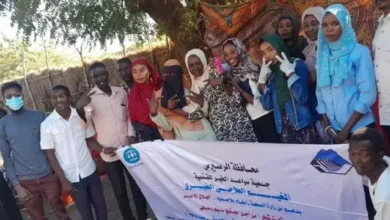Inspired by the experience of the Singapore state in rebirth after the end of this damn war ✍️ Professor: Fikri Kabashi, Al-Amin Al-Arabi

Singapore's renaissance was not the result of the moment, but rather the result of the tremendous efforts of the hero of the Singaporean state, Lee Kuan Yew. He appeared before the media, bursting into tears after Malaysia's decision to secede and abandon the state. the island of Singapore, of which it was a part. In 1965, Malaysia dealt a heavy blow to this small, poor country with limited resources. It suffered greatly from administrative, financial and security corruption, and Singapore was ranked at that time as one of the poorest countries. The most dangerous places in the world due to their exposure to crime and theft prevailed to a very large extent.
The Republic of Singapore is a very small country in terms of area. When independence was achieved in 1965, its area was no more than half that of Bahrain, or one-tenth the area of the Emirate of Dubai (and I do not wish to compare any of the regions and states of Sudan with their resources).
It also has no natural resources within its territory. There is no oil at all! There is no natural gas and there is no mineral wealth that can be explored. Furthermore, it gained independence at a time of turmoil in a region lacking political stability. Worse still, it is home to a multi-ethnic population. The Chinese make up 75%, while the Malays make up 15% and the Indians 8%. If we turn to beliefs, the situation is no better, as we have before us a very diverse mix that includes Muslims, Christians, Hindus, Buddhists, Taoists and other religions and sects. Knowing this, it is not surprising that outside observers confidently predicted that Singapore would not survive and that its failure would be the result of external pressures or internal unrest. However, contrary to all their expectations, Singapore has become the most prosperous country in modern human history, as it has managed to improve the living standards of its people at a faster and more comprehensive pace than any other country.
In the Economist Intelligence Unit's Quality of Living Index published in The Economist magazine, Singapore ranks first in Asia and eleventh in the world, and has the ninth-highest reserve in the world. The country has a well-equipped national army that relies on the latest weapons, according to the Henley Index. In 2014, the Singaporean passport ranked sixth in the world, allowing its holder to enter 167 countries without a prior visa. Singapore has now become the fourth-largest financial center in the world and the fifth-richest country in the world in terms of hard currency reserves. It is the third-largest source of foreign exchange, with five and a half million tourists arriving in Singapore each year. The average per capita income of the gross national product reached sixty-four thousand dollars in 2013, making Singapore the fourth-largest financial center in the world. The unemployment rate is less than three percent and it is considered the leading financial and technology center in the region. The cleanest city in the world has a magnificent view and clean air. Skyscrapers, modern and elegant geometric buildings, tall palm trees, trees and beautiful green gardens make it a paradise on earth.
How did Singapore, a small island in Southeast Asia with no natural resources, become one of the most developed countries in the world? How did its existing system of government and political structure enable it to create the largest economies and most prosperous societies in the world in just a few decades? What is the “secret sauce” behind Singapore’s success? Just look at the key ingredient of this success: the merit-based system. Through a unique combination of policies that prioritize merit, ability, and every other characteristic, Singapore was able to develop an equitable education system for all and an advanced civil service that ensures effective government action, raises national productivity levels, achieves sustainable development, and builds societal cohesion. The meritocratic system of governance was truly the engine of Singapore’s progress, and after returning from Oxford University, Lee Kuan Yew was a fine lawyer and a seasoned politician, the first Secretary-General and founding member of the People’s Action Party. He saw how backward and reactionary his country had become, which made him even more regretful and remorseful for a country that some considered to be outside the planet Earth. Then came the general election and Lee Kuan Yew won the post of Prime Minister of the planet. the Republic of Singapore and ruled it for three consecutive decades, creating a modern renaissance in light of the difficult and arduous circumstances his country had witnessed.
He suffered many shocks during his reign. He could do nothing but a poor and backward people and a poor government, accustomed to living on administrative, financial and moral corruption. communal ethnic conflicts and conflicts between more than three races: Chinese, Malays, Indians and East Asians. He dreamed of transferring … Singapore from the third world country to the first world. He built a homeland for the citizen, not a homeland for himself, because the island was only a fishing village devoid of natural resources. It was founded by Sir Thomas Stamford Raffles in 1819 AD, and its importance as a port for warships emerged. Since that time.
Lee Kuan Yew began to change the systems of his country and enact new laws little by little, curbing the administrative and financial corruption of his government and people. Lee Kuan Yew managed to build an economic renaissance and make his country one of the best. important countries in the world, as he dreamed, while his policy of investing in people was adopted. The Singaporean himself, through education, the intensification of scientific missions abroad and the development of the humanitarian and industrial level as a whole, made Singapore his way by relying on human. resources and qualified people. Lee Kuan Yew saw that there is no economic renaissance except in the investment and qualification of the individual himself, therefore he developed modern scientific programs and focused on the training of the teacher, because it is the essential basis for the construction of future generations. Its population exceeds five and a half million and its area is 2,776 square miles. Thus, Lee Kuan Yew is considered a legend of the magic of the past and the glory of the future Lee Kuan Yew, the builder of the Singaporean renaissance, succeeded in extinguishing all these ethnic conflicts within the country, by unifying the language. and made the priorities of the nation first and applied them to all religious and ethnic classes, and that the nation belongs to all.
Singapore's economy is considered a free market economy and the economy is ranked as the most open in the world and the third least corrupt economy. It is also ranked as the most business-friendly economy. Singapore's tax rates are low (14.2% of GDP), and the country ranks third in the world in terms of GDP per capita (purchasing power parity). In addition to being a business-friendly economy, Singapore's state-owned enterprises play a significant role in the country's economy. The fund called Temasek Holdings holds controlling stakes in several of the country's largest companies, such as Singapore Airlines, Singtel, ST Engineering, and Media Corp. The Singaporean economy is considered one of the major financiers of the flow of foreign direct investment in the world. has also benefited from the inflow of foreign direct investment from global investors and institutions due to its highly attractive investment climate, as well as the stable and diversified political environment in recent years. Singapore's exports are in the electronics, chemical and service industries, and exports are the main source of income for the country's economy. Singapore does not have sufficient natural resources, especially water resources, which are scarce, so the country relies heavily on other countries to import the natural resources and raw materials it lacks. The country enjoys a respected position regionally as a wealth management center. Singapore also has limited arable land, so the country relies heavily on agricultural technology complexes for agricultural production, and the Biopolis Center is a pioneer in this field. Human resources are another vital issue for the Singaporean economy. In 2014, Singapore's economy ranked second in the Scientific American Biotechnology ranking. As I mentioned, Singapore depends on purchasing raw materials and refining them for re-export, as is the case in the wood chip and oil refining industries.
Singapore has a strategic port that makes it more competitive than many of its neighbours in carrying out such trade activities. In 2017, the Port of Singapore ranked second in the world in terms of cargo movement. Singapore’s trade-to-GDP ratio is among the highest in the world, averaging around 400% during the period 2008-2011. To maintain its international position and increase its economic prosperity in the 21st century, Singapore has taken steps to promote innovation, encourage entrepreneurship and retrain its workforce. The Ministry of Manpower is the agency responsible for establishing, amending and implementing immigration rules for foreign workers, as approximately 243,000 foreign workers work in Singapore.
Professor: Fikri Kabbashi, Al-Amin Al-Arabi.





